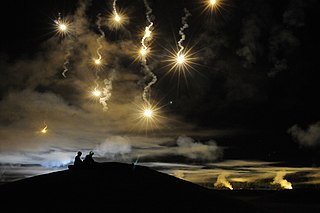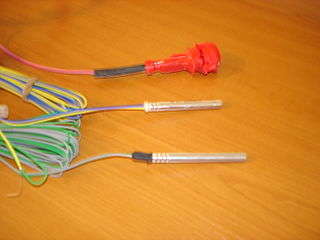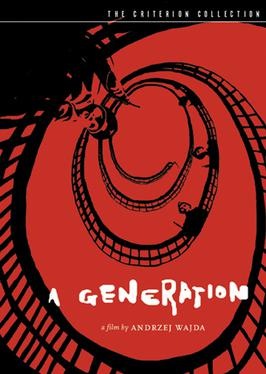
A flare, also sometimes called a fusée, fusee, or bengala, bengalo in several European countries, is a type of pyrotechnic that produces a bright light or intense heat without an explosion. Flares are used for distress signaling, illumination, or defensive countermeasures in civilian and military applications. Flares may be ground pyrotechnics, projectile pyrotechnics, or parachute-suspended to provide maximum illumination time over a large area. Projectile pyrotechnics may be dropped from aircraft, fired from rocket or artillery, or deployed by flare guns or handheld percussive tubes.

A detonator, sometimes called a blasting cap in the US, is a small sensitive device used to provoke a larger, more powerful but relatively insensitive secondary explosive of an explosive device used in commercial mining, excavation, demolition, etc.

Pyrotechnics is the science and craft of creating such things as fireworks, safety matches, oxygen candles, explosive bolts and other fasteners, parts of automotive airbags, as well as gas-pressure blasting in mining, quarrying, and demolition. This trade relies upon self-contained and self-sustained exothermic chemical reactions to make heat, light, gas, smoke and/or sound. The name comes from the Greek words pyr ("fire") and tekhnikos.

In an explosive, pyrotechnic device, or military munition, a fuse is the part of the device that initiates function. In common usage, the word fuse is used indiscriminately. However, when being specific, the term fuse describes a simple pyrotechnic initiating device, like the cord on a firecracker whereas the term fuze is used when referring to a more sophisticated ignition device incorporating mechanical and/or electronic components, such as a proximity fuze for an M107 artillery shell, magnetic or acoustic fuze on a sea mine, spring-loaded grenade fuze, pencil detonator, or anti-handling device.
Insensitive munitions are munitions that are designed to withstand stimuli representative of severe but credible accidents. The current range of stimuli are shock, heat and adjacent detonating munitions. A munition can have its vulnerability reduced by a number of means used on their own or in combination such as a reduced vulnerability energetic material, design features, additions or changes to packaging etc. The munition must still retain its terminal effect and performance within acceptable parameters.

A Generation is a 1955 Polish film directed by Andrzej Wajda. It is based on the novel Pokolenie by Bohdan Czeszko, who also wrote the script. It was Wajda's first film and the opening installment of what became his Three War Films trilogy set in the Second World War, to be followed by Kanał and Ashes and Diamonds.
A slapper detonator, also called exploding foil initiator (EFI), is a detonator developed by Lawrence Livermore National Laboratory, US Patent No. 4,788,913. It is an improvement over the earlier exploding-bridgewire detonator. Instead of directly coupling the shock wave from the exploding wire, the expanding plasma from an explosion of a metal foil drives another thin plastic or metal foil called a "flyer" or a "slapper" across a gap, and its high-velocity impact on an explosive then delivers the energy and shock needed to initiate a detonation. Normally all the slapper's kinetic energy is supplied by the heating of the plasma by the current passing through it, though constructions with a "back strap" to further drive the plasma forward by magnetic field also exist. This assembly is quite efficient; up to 30% of the electrical energy can be converted to the slapper's kinetic energy. The device's name is derived from the English word 'slap'.

A cap gun, cap pistol, or cap rifle is a toy gun that creates a loud sound simulating a gunshot and smoke when a small percussion cap is ignited. Cap guns were originally made of cast iron, but after World War II were made of zinc alloy, and most newer models are made of plastic. Cap guns get their name from the small discs of shock-sensitive explosive compounds that provide the noise and smoke, effectively the same as the Maynard tape primer and percussion caps used in real firearms of the mid to late 1800s but usually smaller and made from cheap plastic or paper. Some are arranged in plastic rings of eight or twelve. There are also single caps, roll caps, disk caps, and cap strips all of which are actually extremely small versions of percussion fireworks. Armstrong's mixture is often used today as the explosive, but previously the tiny powder charge was a simple mixture of potassium perchlorate, sulfur, and antimony sulfide sandwiched between two paper layers that hold in the gases long enough to give a sound report when the cap is struck.
The United States Army divides supplies into ten numerically identifiable classes of supply. The North Atlantic Treaty Organization (NATO) uses only the first five, for which NATO allies have agreed to share a common nomenclature with each other based on a NATO Standardization Agreement (STANAG). A common naming convention is reflective of the necessity for interoperability and mutual logistical support.

An electric match is a device that uses an externally applied electric current to ignite a combustible compound.
Magnesium/Teflon/Viton (MTV) is a pyrolant. Teflon and Viton are trademarks of DuPont for polytetrafluoroethylene, (C2F4)n, and fluoroelastomer, (CH2CF2)n(CF(CF3)CF2)n.
In pyrotechnics, a pyrotechnic initiator is a device containing a pyrotechnic composition used primarily to ignite other, more difficult-to-ignite materials, such as thermites, gas generators, and solid-fuel rockets. The name is often used also for the compositions themselves.

Chemring Group is a global business providing a range of advanced technology products and services to the aerospace, defence and security markets. Chemring has extensive operations in the Americas, Europe, Middle East and Asia.

The following outline is provided as an overview of and topical guide to mining:
Crane Army Ammunition Activity (CAAA) in Crane, Indiana produces and provides conventional munitions requirements in support of United States Army and Joint Force readiness. It is one of 17 installations of the Joint Munitions Command and one of 23 organic industrial bases under the U.S. Army Materiel Command, which include arsenals, depots, activities and ammunition plants. Established in October 1977, it is located on Naval Support Activity Crane.
A bridgewire or bridge wire, also known as a hot bridge wire (HBW), is a relatively thin resistance wire used to set off a pyrotechnic composition serving as pyrotechnic initiator. By passing of electric current it is heated to a high temperature that starts the exothermic chemical reaction of the attached composition. After successful firing, the bridgewire melts, resulting in an open circuit.

The electric flash-lamp uses electric current to start flash powder burning, to provide a brief sudden burst of bright light. It was principally used for flash photography in the early 20th century but had other uses as well. Previously, photographers' flash powder, introduced in 1887 by Adolf Miethe and Johannes Gaedicke, had to be ignited manually, exposing the user to greater risk.
Pyroshock, also known as pyrotechnic shock, is the dynamic structural shock that occurs when an explosion or impact occurs on a structure. Davie and Bateman describe it as: "Pyroshock is the response of a structure to high frequency, high-magnitude stress waves that propagate throughout the structure as a result of an explosive event such as an explosive charge to separate two stages of a multistage rocket." It is of particular relevance to the defense and aerospace industries in that they utilize many vehicles and/or components that use explosive devices to accomplish mission tasks. Examples include rocket stage separation, missile payload deployment, pilot ejection, automobile airbag inflators, etc. Of significance is the survival and integrity of the equipment after the explosive device has activated so that the vehicle can accomplish its task. There are examples of flight vehicles Boeing-The Aerospace Corp which have crashed after a routine explosive device deployment, the cause of the crash being determined as be a result of a computer failure due to the explosive device. The resultant energies are often high g-force and high frequency which can cause problems for electronic components which have small items with resonant frequencies near those induced by the pyroshock.

A bullet hit squib or a blood squib is a practical, pyrotechnic special effect device used mainly in the film industry, TV shows and stage performances and even in first responder moulage training to simulate the appearance of a person being shot and wounded. This is achieved by blowing open a pre-scored hole on the actor's clothing and bursting a fake blood packet with a small explosion, creating an aesthetic that filmmakers and audiences alike have become accustomed to associating with a gunshot wound.

Stage clothes worn by actors who portray characters that are shot and wounded in movies, TV shows, or theatre productions are modified to conceal special effects equipment such as squibs, wires and controllers are commonly referred to as "dead-character costumes." These costumes are a crucial element to create a captivating and dramatic scene. Typically, several identical sets of these costumes are prepared for the planned number of takes as "consumables" and are used only once. After use, they are placed on the "dead-character rack" and not reused, unlike other clothing articles that return to the costume shop.















